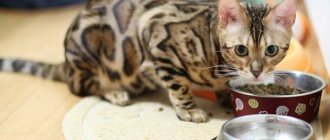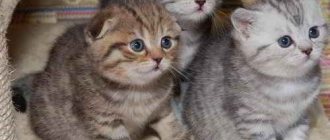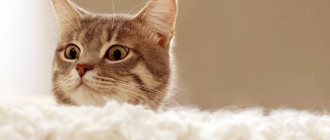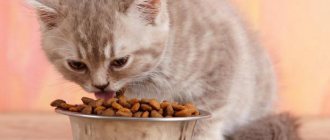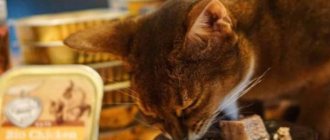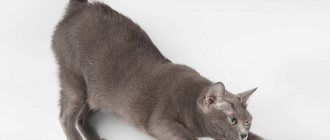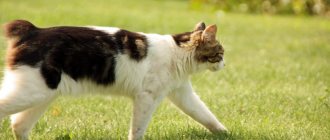Show class
Even if the kitten is only 6-7 weeks old, you can already enroll it in this class. Experts determine compliance with the class based on the phenotype, potential and history of kittens from previous litters from these parents. The breeder can only assume that the pet will successfully participate in exhibitions and, perhaps, move to the top show class. However, the opposite can also happen - the kitten will subsequently not be able to fit this category. If such a situation occurs, the class will be downgraded. However, the phenotype of such kittens is as identical as possible to the breed standard, so in appearance they are ideal “Bengals”.
Kitten from the street: main problems
The way to adopt a kitten from the street seems to be the easiest. But the owner will have to face a number of difficulties. Such an animal is usually diagnosed with at least one disease, and more often a whole bunch, they require mandatory treatment from a veterinarian. The costs of which sometimes exceed the cost of a purebred kitten.
If a small child lives in the house, it is dangerous to bring a kitten from the street, because it may have worms, lichen and other diseases that can be transmitted to people. Also, you should not expect such a pet to be calm and affectionate, because it is not socialized and has not lived with people before. In this regard, kittens that were born in an ordinary apartment and were not weaned from the cat early win. An animal taken from the street needs to be tamed for a long time.
Breeding class
The breeding class includes animals that meet several criteria.
1. Cats that, in terms of external characteristics, “do not reach” the show class, but this does not prevent them from producing offspring that meet the breed standards. Kittens from such parents may well get into the show class, perform at exhibitions and take prizes.
2. Cats that do not have any disqualifying characteristics, but still have slight deviations from the breed standard. These could be, for example, too large ears, unclear color patterns, long hair, soft profile, etc. These shortcomings can be corrected in the offspring by wisely selecting partners for such animals.
At the same time, “Bengalis” of the breed class can also participate in exhibitions. However, they often cannot count on grades higher than the initial ones. Although the appearance of a cat is a subjective question, and the class is not indicated in documents (metrics, pedigrees), except in cases where the cat does not have the right to breed due to obvious shortcomings.
Tribal classes
All breeding classes assigned to kittens after the litter is registered at one and a half months of age must be examined by certified felinologists.
Important! It should be remembered that initially only a potential class is assigned to an animal, and the actual relationship of a pet to this class can only be confirmed by a professional expert when examining a cat or female cat at the age of ten months.
Show class animals
A conditional class of kittens that requires confirmation in the future.
This is interesting! Show-class pets must have a pronounced exterior, show character, and any shortcomings must be completely absent.
In this case, the breeder declares only the level of prospects of the kitten being sold.
Breed class animals
Kittens belonging to this class correspond to all breed qualities and characteristics, and also do not have defects and shortcomings that preclude work in breeding.
This is interesting! The Breed class is a broad group of animals with conformations ranging from simple standards to pronounced conformations.
A cat of this class gives birth to kittens of the appropriate type, easily bears and feeds its offspring. Animals of the breeding class are always adequate in mating.
Pet class animals
The class is represented by purebred kittens that have breeding defects in the form of disadvantages that preclude the use of the animal for breeding.
This is interesting! This class also includes pets that have insufficiently expressed qualities or characteristics.
Pet-class kittens, after reaching the age of ten months or a year, must be sterilized or neutered, after which they can take part in exhibition shows in the Premier class.
Pet class
These are purebred pets of their owners that have either disqualifying characteristics or a weak phenotype. They cannot participate in exhibitions and are not used for breeding. However, this does not prevent them from being favorite pets for their owners. If you choose a pet-class kitten, this does not mean that you will get a sick or ugly animal. After all, a disqualifying sign, in the opinion of the judges, may be, for example, a too thick tail vertebra or a white “frill” on the chest. But for loving owners this “defect” does not matter at all.
Best in show in WCF
At the end of each exhibition, a special competition “Best in show” is held, in which cats nominated by experts for Best in show (nom BIS) participate. Cats that have won the title of “best in color” can receive a nomination; adult cats who scored at least 95 points, but were defeated in the competition for “best in color” by a kitten; domestic cats, veterans and litters that score at least 95 points.
The best cats are selected in 5 coat types: LH (Long Hair), SLH (Semi Long Hair), SH (Short Hair), SOSH (Siamese Oriental Short Hair) and SPH (Sphynx). (sometimes sphinxes are combined with the Siamese-oriental group). To divide Best in show into 5 categories, it is necessary that each of them have at least 15 cats. Otherwise, the categories are combined: semi-longhair + longhair; Shorthair+Siamo-Oriental+Sphynx. Or even a single Best in show is held without division into categories.
In each category, each judge has the right to nominate: 1 adult cat, 1 adult cat, 1 neutered cat, 1 sterilized cat, 1 veteran cat, 1 veteran cat, 1 junior cat, 1 junior cat, 1 kitten cat , 1 kitten cat, 1 baby cat, 1 baby cat and 1 litter (in the latter case, all kittens in the litter must score 95 points) and 1 house cat, 1 house cat for their special show.
Best in show titles
| №pp | Rank | Comments |
| 1 | Best of Best | best animal in show among all coat types; The 4 best cats in their type are distributed into 4 prizes |
| 2 | Best Adult | best adult animal in show in its coat type |
| 3 | Best Opposite sex | best adult animal in show in its coat type of the opposite sex (relative to Best Adult) |
| 4 | Best Junior (young) | best junior in show among all coat types (sometimes the best in each coat type is chosen first) |
| 5 | Best Kitten | best kitten in show among all coat types (sometimes the best of each coat type is chosen first) |
| 6 | Best Litter | best litter of the show among all coat types |
| 7 | Best Neuter | best castrato (newer) of the show among all types of wool |
| 8 | Best Veteran | best veteran among all coat types |
| 9 | Best Pet Cat | best pet in show |
Pet-, Breed-, Show-class. What are the differences?
Have you decided to get a purebred kitten? And most likely, you have already chosen his breed and gender? Now think about its breed quality before you tell the nursery owners: “it’s simpler for us, for our home.”
Let's say you are (for now) not interested in exhibitions and you do not plan to engage in breeding. Well, you don’t have any plans, but what about your animal? it will grow. And he will demand the bride or groom, filling the apartment with screams and “shortcomings and vices,” in order to at least prevent gross mistakes. Please note: different international associations may have different standards for the same breed or the same breed may have different names. Don't forget whose standard you're aiming for! You can view the standards on the relevant websites of international organizations.
In advertisements of nurseries you can often find the words: show-, breed- and pet-class kittens. These are breed quality classes. The “pet” class - pets - unites animals that do not sufficiently meet the requirements of the modern standard, are of an outdated type, or have disqualifying defects. If you are purchasing a kitten “for castration”, do not be afraid of the word “defects” - most of them you may not even notice, such as a white spot in the groin of a Russian Blue or a tiny hook on the tip of the tail of a Thai cat. The “show” class is animals of the highest exhibition quality that can qualify for championship titles. But determining the “breed” class is quite difficult. The traditional understanding of this definition is animals that are not of sufficient quality for high titles, that have certain defects in appearance, but are suitable for breeding use. But, frankly, “fitness” alone is not enough to withstand the conditions of breeding competition. Individuals of the “breeding” class (especially cats! It’s a little easier for cats) must have other advantages: for example, origin from high-quality parents whose breeding potential has not yet been sufficiently revealed, or have a rare and necessary breed trait in the local population. Animals that have nothing to boast about either in appearance or in their pedigree are not breed class. On the other hand, not every representative of the “show” class will necessarily turn out to be a quality producer. He, of course, is more amenable to advertising “promotion”, but the level of his offspring will quickly put everything in its place. So, if you are categorically not interested in exhibitions, but you are not averse to breeding, this is a prospect.
There is another class of kittens that you will not find in the literature - kittens that are especially valuable for a nursery or club, necessary for the development and improvement of the breed, or - less often - for advertising at exhibitions. The owner of the nursery would be happy to keep them, but he does not have such an opportunity. Such animals are usually not given for castration, but these kittens can sometimes be a profitable purchase - if you agree to the conditions set by the owner of the nursery and sign the appropriate agreement, their prices may be reduced.
A purebred kitten can also be bought on the market. But still, it’s not worth it - it’s not that you can’t buy a good animal there, but the risk of buying a bad one is too great: sick, not of sufficient breed, with fake documents. Can be purchased at the exhibition. The downside is that you cannot see in what conditions the kittens were raised. But at the exhibition you can usually get advice from club representatives about the prospects of the kitten you are interested in. But it is optimal to purchase a kitten through a club or in a nursery. A club is an organization that unites cat owners and breeders and supervises the work of nurseries owned by these same breeders (more precisely, this is only one of the areas of the club’s work, but this is what we are interested in now). A nursery is, so to speak, an animal breeding enterprise (always small and often unprofitable).
The club is in charge of issuing pedigrees and, in general, all documents for kittens. In Russia (and many other countries), to determine the quality of kittens obtained in nurseries, the club’s felinologists carry out the so-called activation - they determine the breed quality of the kittens, the presence or absence of defects, hereditary diseases, etc. - and enter their data into stud books (real and virtual). Metrics and pedigrees are issued on the basis of stud books. This is how many European felinological organizations are structured.
Clubs can unite into various international associations, federations, etc. But in nursery advertisements you can see the words “direct registration in” - and then some kind of abbreviation. Most likely, this is an American-type nursery. (Direct registration of a cattery in European federations only means that the breeder can receive documents for kittens in any of the clubs of this federation without re-registering his cattery). American associations (and those built on their model) unite nursery owners. The breeder himself submits the data on the kittens born in the nursery to the central office, from where they send him documents for them (the so-called green cards). There, at the central office, future owners of kittens based on green cards will be able to order pedigrees. It is clear that no one at the central office has ever seen these kittens. But do not think that such a system opens the door to abuse - in reputable American associations the exhibition system and breeding are organized in such a way that competition quickly weeds out unscrupulous breeders. It’s another matter if it’s a one-day association. Therefore, if you are going to purchase a kitten from an American-type cattery, find out how long both the cattery itself and the organization where it is registered have existed.
And, finally, another argument in favor of nurseries - almost any high-quality nursery will offer the new owner of a kitten advice on its maintenance, and often assistance in veterinary care. The breeder must have documents confirming the origin of each purebred kitten. The new owner of the animal has the right to take or not take (not redeem) these documents. If you are not going to show it at exhibitions, you do not need them. Still, it’s better to take the documents - you never know how the circumstances will turn out. Pedigree cats without documents are accepted to many exhibitions, but clubs either do not accept them for breeding at all, or are extremely reluctant to accept them.
Usually, together with the kitten, you can receive one of the following documents: 1. pedigree, 2. metrics (“kitten card”) or green card (if this is an American cattery), or a coupon card for obtaining a pedigree. Based on any of the last three documents, you can order and receive a pedigree from the club or association whose name is indicated in the document. The difference between a metric and a coupon card: the former have their own numbering system, and the number indicated in the latter is the number of pedigrees according to the stud book. And one more thing: the metric usually indicates the names and breed/color of the kitten’s parents, but the coupon card does not contain this information.
Pedigree is the main document about the origin of an animal, which indicates its stud book number, nickname, breeder, main characteristics (date of birth, gender, color, breed, etc.), ancestors in 4-5 generations. Naturally, the pedigree must indicate the club (association) in which the animal was registered, and there must be a seal of this organization. Don't believe what they tell you. that the kitten is not entitled to a pedigree and can only receive it after being assessed at an exhibition. A club that withholds pedigrees arouses suspicion (either it is a way to hide the resulting breeding marriage, or an attempt to forcibly “bind” new owners to this club). But the breeder really has the right not to order pedigrees for kittens, being content with the metrics - let the new owners order. As for the problem of “breeding marriage”, that is, kittens with disqualifying defects, information about them should be equally present in the pedigree and in the metrics. Usually this is a stamp “without the right of breeding use”, clearly printed on the pedigree (or inscribed on the metric, coupon card). Another thing is that hardly anyone needs such pedigrees...
Two more features reflected in the pedigree and metrics. The pedigree (metric) number may contain an additional letter “E” (or, if the club uses Cyrillic when numbering pedigrees, “E”). This means that this is an animal of experimental breeding - either all of its ancestors over four generations are unknown, or among its ancestors over the same four generations there are individuals of a different breed (this happens, for example, when new breeds and colors are bred). Or, finally, your animal belongs to a breed that does not yet have “full” status (that is, the right to all championship titles) in this felinological association. In the columns “breed” and “color” in the metric or in the coupon card there is often some kind of abbreviation that is not always disclosed. You can see the same thing in the pedigree - in the columns relating to the kitten’s ancestors, the abbreviation is also often not disclosed. These are the so-called EMS breed and color codes. The abbreviation used depends on the felinological association, but there are two fairly universal elements - the signs “non” and “x”. Used in the color code, they mean the same thing - the color of the animal is not recognized in this breed. Such an animal cannot lay claim to the championship title, no matter what its other qualities are. As for breeding prospects, it depends on the desirability of this color for a given breed. The “non” signs in the breed code indicate that the animal does not belong to any breed. This happens in new and experimental breeds - kittens are produced that are deprived of one or two fundamentally important breed characteristics. Such “outbred” individuals, but descended from good parents, do not participate in exhibitions and are usually not used for breeding (although there are exceptions!).
Some breeders sell their kittens only upon signing an agreement with the future owner - they stipulate participation in exhibitions, breeding use, and the possibility of the manifestation of hereditary diseases. In general, with any purchase of kittens, when the owner and breeder take on some additional obligations, an agreement should be drawn up, certified by the club or even notarized (if it comes to financial settlements). If you violate it, it is unlikely that anyone will drag you to court, but at the level of the felinological association - participation in exhibitions, planned breeding - measures will most likely be taken.
It is better to purchase a kitten that has received all the necessary vaccinations, that is, 3-4 months old. At this age, the quality of the breed is visible better than in a one and a half month old baby. The necessary vaccination against infectious diseases is carried out with the so-called polyvalent vaccine. Your kitten most likely does not need a rabies vaccination (if you do not live in a private house and do not take it out to the country), but it - or rather, a certificate of it - may be required by the veterinary service. Some polyvalent vaccines also include rabies. Vaccination against fungal diseases (lichen) and chlamydia is also desirable. All vaccinations given to the kitten must be noted in its veterinary passport, otherwise you will have to find a way to fill out this passport.
Author: Inna Shustrova , Candidate of Biological Sciences,
felinologist, expert of the international category WCF

